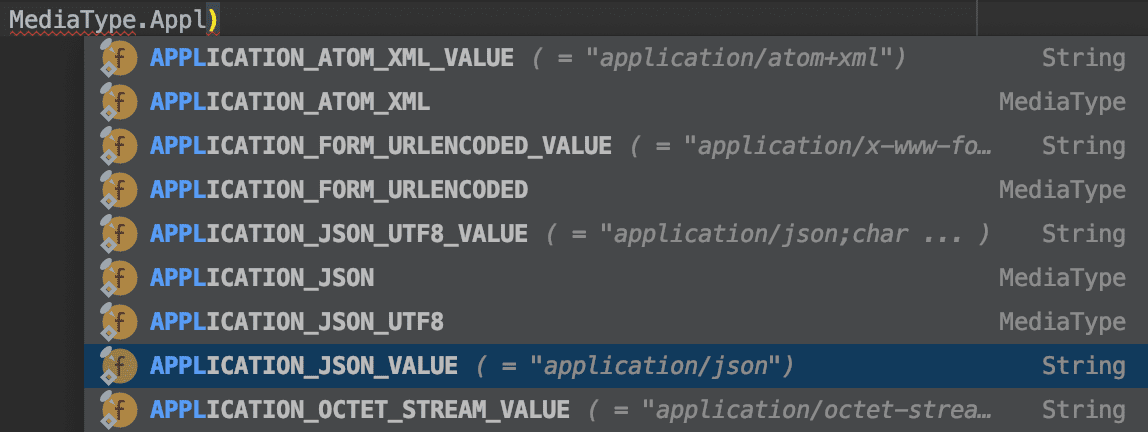이 글의 코드 및 정보들은 강의를 들으며 정리한 내용을 토대로 작성하였습니다.
Consumes
-
특정 타입의 데이터를 담고 있는 요청만
처리하는 핸들러 지정이 가능하다.
ex) @RequestMapping(consumes=MediaType.APPLICATION_JSON_VALUE)
-
Content-Type 헤더로 필터링을 한다.
= 핸들러에 consumes 조건을 추가하여 요청을 필터링한다.
-
매치 되는 않는 경우엔 415 : Unsupported Media Type 응답한다.
-
핸들러에 consumes라는 키워드를 사용하여
어떤 미디어 타입을 허용할 것인지 핸들러에게 명시해준다.
@Controller
@RequestMapping
public class SampleController {
// String을 Return하는 것들은 끝에 VALUE가 붙는다.
// 아래 사진 참고
@GetMapping(value = "/hello", consumes = MediaType.APPLICATION_JSON_VALUE)
@ResponseBody
public String hello() {
return "hello";
}
}

-
위 핸들러는 HTTP 헤더 중
Content-Type이라는 HTTP 헤더에
“application/json”
(=MediaType.APPLICATION_JSON_VALUE)라는 값이 있는 경우에만 처리를 한다.
라고 위 핸들러를 해석할 수 있다.
-
즉 HTTP 요청 시
그 HTTP 요청에 들어가는 본문의 타입을
서버에 알려주는 기능을 한다.
그리고 서버는 조건에 맞는 요청만 처리를 한다.
- 다음과 같이 Headers가 없는 상태로 요청을 해보자.
@Test
public void helloTest() throws Exception {
mockMvc.perform(get("/hello"))
.andDo(print())
.andExpect(status().isOk());
}
-
다음과 같은 결과를 볼 수 있다.
-
HTTP Status Code값으로는 415 : Unsupported Media Type를 받게 된다.
The HTTP 415 Unsupported Media Type client error response code indicates that the server refuses to accept the request because the payload format is in an unsupported format.
MockHttpServletRequest:
HTTP Method = GET
Request URI = /hello
Parameters = {}
Headers = [] // Headers가 없는 상태로 요청을 했다.
Body = <no character encoding set>
Session Attrs = {}
...
MockHttpServletResponse:
Status = 415
Error message = null
Headers = [Accept:"application/json"]
Content type = null
Body =
Forwarded URL = null
Redirected URL = null
Cookies = []
java.lang.AssertionError: Status
Expected :200
Actual :415
-
Content Type을 담아서 요청을 해보자.
-
TC가 성공하는 것을 확인할 수 있다.
@Test
public void helloTest() throws Exception {
mockMvc.perform(get("/hello")
.contentType(MediaType.APPLICATION_JSON))
.andDo(print())
.andExpect(status().isOk());
}
MockHttpServletRequest:
HTTP Method = GET
Request URI = /hello
Parameters = {}
Headers = [Content-Type:"application/json;charset=UTF-8"]
Body = null
Session Attrs = {}
...
MockHttpServletResponse:
Status = 200
Error message = null
Headers = [Content-Type:"text/plain;charset=UTF-8", Content-Length:"5"]
Content type = text/plain;charset=UTF-8
Body = hello
Forwarded URL = null
Redirected URL = null
Cookies = []
Accept 헤더
- 만약 요청을 하는데 특정 타입의 응답을 원한다면 Accept 헤더를 사용하면 된다.
@Test
public void helloTest() throws Exception {
mockMvc.perform(get("/hello")
.contentType(MediaType.APPLICATION_JSON)
.accept(MediaType.APPLICATION_JSON))
.andDo(print())
.andExpect(status().isOk());
}
MockHttpServletRequest:
HTTP Method = GET
Request URI = /hello
Parameters = {}
Headers = [Content-Type:"application/json;charset=UTF-8", Accept:"application/json"]
Body = null
Session Attrs = {}
-
Headers에
Accept:”application/json”가 추가되는 것을 볼 수 있다.
Produces
- produces 조건을 추가하여 요청에 대한 필터링을 할 수 있다.
@GetMapping(value = "/hello",
consumes = MediaType.APPLICATION_JSON_VALUE,
produces = MediaType.TEXT_PLAIN_VALUE
)
@ResponseBody
public String hello() {
return "hello";
}
Test Success
// 요청하는 consumes과 produces의 타입이
// 핸들러가 처리하는 consumes과 produces의 타입과 동일하다.
@Test
public void helloTest_Success() throws Exception {
mockMvc.perform(get("/hello")
.contentType(MediaType.APPLICATION_JSON)
.accept(MediaType.TEXT_PLAIN_VALUE))
.andDo(print())
.andExpect(status().isOk());
}
MockHttpServletRequest:
HTTP Method = GET
Request URI = /hello
Parameters = {}
Headers = [Content-Type:"application/json;charset=UTF-8", Accept:"text/plain"]
Body = null
Session Attrs = {}
...
MockHttpServletResponse:
Status = 200
Error message = null
Headers = [Content-Type:"text/plain;charset=UTF-8", Content-Length:"5"]
Content type = text/plain;charset=UTF-8
Body = hello
Forwarded URL = null
Redirected URL = null
Cookies = []
Test Fail
// 요청하는 consumes과 produces의 타입이
// 핸들러가 처리하는 consumes과 produces의 타입과 다르다.
@Test
public void helloTest_Fail() throws Exception {
mockMvc.perform(get("/hello")
.contentType(MediaType.APPLICATION_JSON)
.accept(MediaType.APPLICATION_JSON))
.andDo(print())
.andExpect(status().isOk());
}
MockHttpServletRequest:
HTTP Method = GET
Request URI = /hello
Parameters = {}
Headers = [Content-Type:"application/json;charset=UTF-8", Accept:"application/json"]
Body = null
Session Attrs = {}
...
MockHttpServletResponse:
Status = 406
Error message = null
Headers = []
Content type = null
Body =
Forwarded URL = null
Redirected URL = null
Cookies = []
java.lang.AssertionError: Status
Expected :200
Actual :406
- HTTP Status Code값으로는 406 : Not Acceptable를 받게 된다.
The HyperText Transfer Protocol (HTTP) 406 Not Acceptable client error response code indicates that the server cannot produce a response matching the list of acceptable values defined in the request’s proactive content negotiation headers, and that the server is unwilling to supply a default representation.